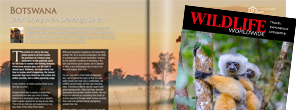Northern Territory, Australia

As the plane started its descent into Darwin, I felt as if I was arriving somewhere rather special. The blazing red earth, rugged gorges and parched landscapes interspersed with shimmering billabongs were the authentic Australia I had heard so much about.
When browsing a map, some names - Uluru, Katherine Gorge and Kakadu - stand out as being synonymous with the outback. The sense of adventure and anticipation is only heightened when you realise the sheer scale of Northern Territory: 1.5 million square kilometres i.e. more than four times the size of Germany, yet with fewer than 250,000 inhabitants!
Kakadu is the region’s most famous national park - and deservedly so. My introduction was sunset at Canon Hill bathing the rocky outcrops, whispering marshlands and distant escarpment with golden light. The colours of Kakadu are vivid by day, but at twilight they positively glow!
The birdlife is impressive - one third of Australia’s species, ranging from white-lined honeyeater and azure kingfisher to whistling kite and
 white-bellied sea eagle, though the most iconic is the jabiru stork, which gives its name to Kakadu’s main settlement. The most infamous inhabitant of all, though, is the crocodile. Both freshwater and saltwater crocodiles inhabit the rivers, but ‘salties’ are almost twice as large! On one boat trip I saw no fewer than 30 sunning themselves on the banks, so who knows how many lurked beneath the surface?
white-bellied sea eagle, though the most iconic is the jabiru stork, which gives its name to Kakadu’s main settlement. The most infamous inhabitant of all, though, is the crocodile. Both freshwater and saltwater crocodiles inhabit the rivers, but ‘salties’ are almost twice as large! On one boat trip I saw no fewer than 30 sunning themselves on the banks, so who knows how many lurked beneath the surface?
There is more to Northern Territory than just Kakadu however, with a number of intriguing places to visit. Arnhem Land, in the northeast corner of NT, 500 kilometres east of Darwin, is very remote, yet well worth the effort of getting there. It positively bursts with aboriginal culture, stunning landscapes and rich wildlife - more than 280 bird species plus one fifth of Australia’s mammal species -
 and encapsulates so many of the good things that Australia has to offer. The best time to visit is in dry season between June and August, when wildlife congregates around the remaining creeks and billabongs. On my first outing, as we picked our way through the paperbark and eucalypt trees towards a large wetland, we became aware of a gentle humming sound. As we reached the shore, this turned into a cacophony as thousands of magpie geese that were feeding in the shallow waters took to the air in chaos each time a white-bellied sea eagle flew over.
and encapsulates so many of the good things that Australia has to offer. The best time to visit is in dry season between June and August, when wildlife congregates around the remaining creeks and billabongs. On my first outing, as we picked our way through the paperbark and eucalypt trees towards a large wetland, we became aware of a gentle humming sound. As we reached the shore, this turned into a cacophony as thousands of magpie geese that were feeding in the shallow waters took to the air in chaos each time a white-bellied sea eagle flew over.
Mount Borradaile, on the western edge of Arnhem Land, is a paradise with rock wallabies among the trees and salties in the waterways. However it also has some of Australia’s best preserved aboriginal artefacts and artwork. Its gorges, caverns and sacred burial sites tucked away in various nooks and crannies yield an array of pristine rock art that outdoes that of neighbouring Kakadu. This creates a rich cultural dimension that allows you to learn about the region’s indigenous people, and there’s always an opportunity to sample bush tucker with your local guide!
 In this wilderness time has seemingly stood still and nature has been allowed to take its course, so its habitats and wildlife have flourished unhindered. The well-preserved cultural and historical sites tell of a bygone age where humans co-existed in harmony with nature. With its diverse flora and fauna, dramatic scenery and cultural richness, Northern Territory has much to offer, and much that simply can’t be seen anywhere else.
In this wilderness time has seemingly stood still and nature has been allowed to take its course, so its habitats and wildlife have flourished unhindered. The well-preserved cultural and historical sites tell of a bygone age where humans co-existed in harmony with nature. With its diverse flora and fauna, dramatic scenery and cultural richness, Northern Territory has much to offer, and much that simply can’t be seen anywhere else.
Explore our range of trip ideas in Australia's Northern Territory, or contact Chris to discuss your perfect tailor made wildlife holiday down under.








